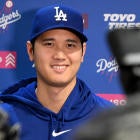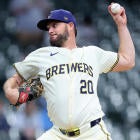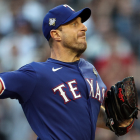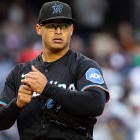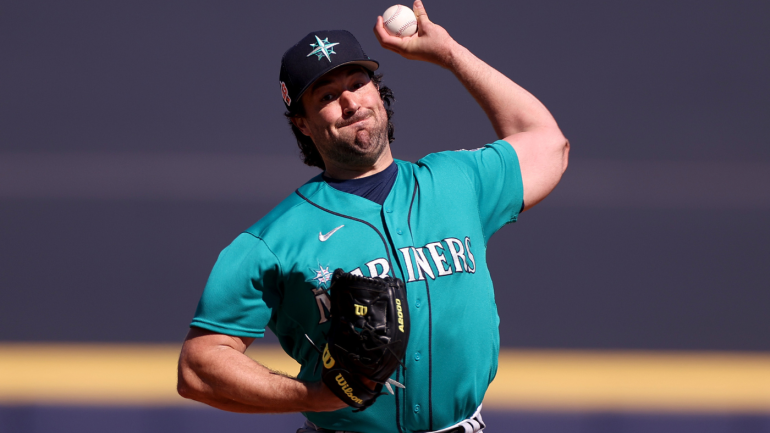
On Friday, the Seattle Mariners and San Francisco Giants agreed to a surprising three-player trade that included former Cy Young Award winner Robbie Ray and veteran outfielder Mitch Haniger. As part of the deal, the Giants also sent righty Anthony DeSclafani and $6 million to Seattle to balance the books.
As CBS Sports is prone to do, believe we've rendered instant judgement on both sides of the trade, complete with a letter grade. First, though, let's lay out the exact terms of the agreement:
- Mariners receive: OF Mitch Haniger, RHP Anthony DeSclafani, approximately $6 million in cash considerations
- Giants receive: LHP Robbie Ray
Now, onto our full analysis.
Mariners grade: B
Haniger, 33, returns to the same organization he spent six seasons with prior to departing through free agency last winter. The book on him had been the same for years: highly productive when healthy. He remained snakebitten by injury in 2023, appearing in 61 games because of a fractured forearm and a strained back. Unfortunately, he just wasn't productive when he played, tallying a 73 OPS+ that qualified as the worst of his big-league career, no matter the sample size or larger circumstances.
There's no telling how much Haniger's body will allow him to play in 2024. We do think there's reason to be rosy about his odds of delivering a better output at the plate. Indeed, he continued to hit the ball hard and command the strike zone last season, compiling some underlying data that indicates he should've finished with a much better line than the one he put up.
If Haniger does bounce back, he'll be an important part of a remade outfield that has shed Jarred Kelenic and Teoscar Hernández through trade and free agency. Flanking Julio Rodríguez will be some combination of Haniger, Luke Raley (if another rumored trade gets completed), Cade Marlowe, Sam Haggerty, Dylan Moore, and/or Taylor Trammell. Is that group an improvement over what the Mariners had in place last season? We're not so sure, even if we like Haniger and some of the other individual pieces.
DeSclafani, 33, had a career-best showing in 2021, his first season with the Giants. In the two seasons since, he's been limited by physical woes to 24 appearances and an 81 ERA+. DeSclafani was shut down last July after suffering a flexor strain in his throwing elbow. That injury, often a precursor to Tommy John surgery, resulted in him receiving a season-ending PRP injection.
| Season | Slider Whiff% | Slider BAA | Slider SLG |
|---|---|---|---|
2023 | 26.9% | .257 | .429 |
2022 | 33.9% | .452 | .516 |
2021 | 32.2% | .224 | .367 |
2020 | 34.8% | .182 | .341 |
2019 | 29.3% | .250 | .392 |
2018 | 36.9% | .194 | .333 |
Even if DeSclafani is hearty and hale to begin the season, it's unclear what kind of value he'll provide. His slider, historically his best offering, has seen its effectiveness crater in recent seasons, as displayed in the table above. It's hard to envision him starting games without regaining that pitch's old form.
It's possible the Mariners don't envision DeSclafani as a starter, but rather as a multi-inning reliever or swingman type. Such is life for a Seattle club who has a handful of more interesting candidates -- Luis Castillo, Logan Gilbert, George Kirby, Bryce Miller, Bryan Woo, Emerson Hancock -- to throw out there every fifth day. There's no harm in letting DeSclafani show up to camp and compete for a spot at the back of the rotation, but based on his recent injury history and reduced effectiveness, it shouldn't surprise anyone if his greatest contribution to the Mariners comes in the form of financial ballast.
If we judged this deal on talent and talent alone, we probably would've given the Mariners a C based on both players' physical uncertainties. We've bumped it to a B because Seattle didn't need Ray to field a good rotation, and now the M's are freed from concerns about Ray's opt-out decision and how that may impact their ability to make other additions. Put another way, the Mariners might have freed up $8.5 million next season (if Ray and Haniger both opt in) and another $25 million for 2026. Financial flexibility is only worthwhile if a team intends to use it. We'll have to wait and see what the Mariners do.
Giants grade: B
Ray, 32, underwent Tommy John surgery last May that ended his season after a single appearance. It used to be that pitchers would return about a year later. In more recent times, teams have erred on the side of caution by giving recovering pitchers about 14 months to complete the cycle. That puts Ray's forecasted return closer to the All-Star Game, give or take a week or two.
In a sense, then, you can view this as the first trade deadline move of the year.
Of course, it's not that straightforward -- this isn't a pure rental situation. There are potential long-term consequences at play. Ray's contract allows him to opt out after the 2024 season, when he'll have two years and $50 million remaining on his deal. If he comes back in July and pitches terribly, the Giants might be stuck with an unattractive deal. Contrariwise, if he comes back and pitches wonderfully, the Giants stand to lose him at season's end. (There's also the possibility that he pitches well and stays in place because moving stinks.)
Divining the odds of either outcome would be difficult even without the operation. Ray isn't far removed from winning the American League Cy Young Award in 2021. He, too, isn't far removed from walking 17.9% of the batters he faced during the abbreviated 2020 campaign. Throwing strikes at the clips he did in 2021-22 is still a nascent development. If it sticks -- and control is often said to be the last thing that returns -- then you should feel decent about his chances of being a positive contributor whenever he steps back on the mound.
Robbie Ray, Nasty Slider. 😨 pic.twitter.com/HlTaiN9ORo
— Rob Friedman (@PitchingNinja) March 28, 2022
To wit, Ray's first season in Seattle wasn't as spectacular as his Cy Young campaign, but he struck out more than 27% of the batters he faced and kept runs off the board at an above-average clip for a starting pitcher. For reference, the Giants had three qualified pitchers with higher strikeout rates last season -- and none of them were what you would describe as a starter (though Ryan Walker, bless his heart, did open 13 games in 2023).
Variance is often thought of as a bad word when it comes to roster building. It's true that in an ideal world the Giants would slot in a pitcher they knew with good certainty would give them three or four wins. There aren't many of those available in any given winter, and besides, the Giants have had troubles securing top-of-the-market talent. So, what else can they do? They can collect back-end starter types and up their floor. Or they can take a swing on someone with Ray's profile, hoping that he does return strong and that they get the sunny side of his variance down the stretch.
There's risk to that play, no doubt. There's also reward that could end up making the difference between contending for a wild-card spot and not. Given the opportunity cost here -- two players with significant injury woes of their own -- we think that rolling the dice on an impact pitcher is a worthwhile play. In turn, that makes this one of those trades that you can understand from both perspectives, even if it looks like an odd trade at first blush.
















